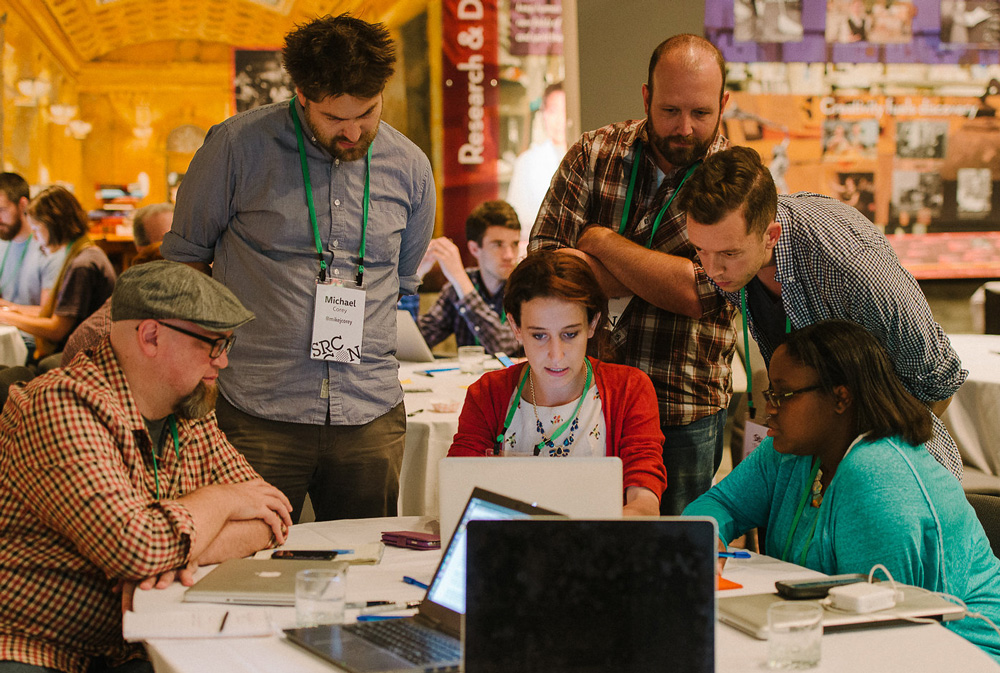3 Ways to Facilitate a Great Conference Session, a Guest Post from Sisi Wei
by Sisi Wei

Mid-discussion at SRCCON 2015. (photo/Erik Westra)
If you’ve never presented at a conference with facilitators instead of speakers before, you’re in for a treat. Facilitation is a much more interactive way of running sessions at conferences, and when done well, both the facilitator and the attendees walk away feeling inspired, motivated, and like they’ve learned a lot from everyone in the room.
So how do you make that happen? Here are my three biggest pieces of advice:
1. Create activities that enable the entire audience to both teach and learn
Everyone in the room has something different to offer, so take full advantage of all your attendees’ backgrounds and experiences. Give them a chance to learn from each other.
One masterful way I’ve seen this done was in a 2014 SRCCON session about how we could redesign the newsroom, facilitated by Tom Meagher. Tom had everyone stand in a circle, and asked a series of questions about our newsrooms and our jobs. Each time, if you answered yes, you stepped forward. Sometimes, discussion followed. Here’s an example question: “Who here thinks their job description actually describes their job?”
A few amazing things happened:
-
Tom had batches of questions that would follow each other, so eventually we formed multiple rings of people, some who had stepped forward once or twice and then stopped, and others who had said yes every time.
-
Participants, myself included, jumped in with our own questions that we wanted the room to answer, which also prompted amazing cross-newsroom discussions.
And what did everyone learn?
- Which concerns were shared by literally everyone there
- Who was in a different position compared to everyone else
- If it was a position we wanted our newsrooms to be in, what can that person share that would help the rest of us get there?
- If it was a bad position, how can the rest of us help him/her change their newsroom for the better?
2. Does your session include controversy? Put people in the heart of it.
People are going to come to your session because they want to either (1) hash it out, (2) be convinced one way or another, or (3) learn what all the fuss is about. Your job is to make sure the discussion everyone wants to see actually happens.
One way to do this, is to give people different (and potentially trying) scenarios, and ask them to vote on how they would act. Then, after the exercise, facilitate a discussion over the actions and their consequences.
Last year at SRCCON, David Yanofsky and Becky Bowers facilitated a wonderful session on enabling reporters to make and publish their own charts. But instead of just telling the attendees what they do at their newsrooms, they asked them to judge for themselves. David and Becky divided the room into 6 teams and showed us one reporter-created chart at a time from their newsrooms (until we hit 10). After each chart, we had to vote as to whether we’d “run” the chart, “fix” it, or “kill” it.
So what did the attendees do?
- Saw when the room voted unanimously, and at other times divergently (Read the session transcript!)
- Debated constructively and passionately when we disagreed
- Organically discussed all the pros and cons of taking this approach
What did people leave with?
- A simulation of what the review process might be like if reporters in their newsroom could create and publish charts
- A more solid idea of whether something like this would work in their individual newsrooms
3. Give them something they can take home with them
Many sessions are centered around finding a better way to do something.
This could be because an existing way is not optimal (you want to fix something), or because you’re excited about a new way to tackle a problem (you want to try something), or both.
Let your attendees be your guinea pigs, and give them the opportunity to create something that will be useful to themselves, and potentially everyone else, after SRCCON is over.
There’s a lot of good examples from past years in sessions like this:
- I facilitated a session with Eric Sagara on how using storytelling tools from dungeons and dragons can help us teach journalism. Attendees left with their own dungeons and dragons journalism adventure, and the experience of playing someone else’s.
- Lena Groeger and Aurelia Moser facilitated a session that compiled everyone’s collective knowledge about what language we should use to promote inclusion in everything from our articles to our job postings. (Read the transcript!)
- Matt Waite facilitated a session where participants took on a basic programming concept and tried to create activities and skits that explained how those concepts worked. At the end of the session we did a group show and tell while Matt compiled all the ideas into a shared document.
Don’t worry about incorporating all of these tips into your session. Even if there’s part of one that you think could fit well with your topic, try it out and see what happens. Just remember: at the end of the day, be prepared, and be ready to collaborate with your audience.
The latest from the OpenNews team
Looking back at 2023: We spent this year creating opportunity
How we connected at SRCCON 2023, and what we're carrying into next year
Read all our news in our OpenNews blog

